Still searching for the source of the newspaper washers; I quickly realised that the Guardian, although founded in 1821, the ‘Manchester Guardian’ didn’t become a national paper, based in London, until 1959. The Times have their own archive which I subscribed to but couldn’t find any of the stories from February 1861. I had once again drawn a blank. The Daily Telegraph was included on the British Newspaper Archive website however, there was a strange anomaly around the dates that I was looking for. Although founded in 1855, a few years were missing from the BNA website, their digitised copies started from 1869. I wasn’t sure if there was simply an omission of digitising and OCR processing these for the website or whether those physical newspapers were missing from the British library. So, I contacted the British library, found that those newspapers did indeed exist and arranged to view them when I was next down in London which was to be in a couple of weeks’ time.
In the meantime, I worked up some ideas that I’d had towards final artwork and sent them off to my client via email and WeTransfer on 17th October 2019:
“I’m including my thoughts around these ideas for you to consider but I think it would be good now to chat through some of these possibilities over the phone. This is not an exhaustive list and something more defined or even totally different might come out of a discussion.”
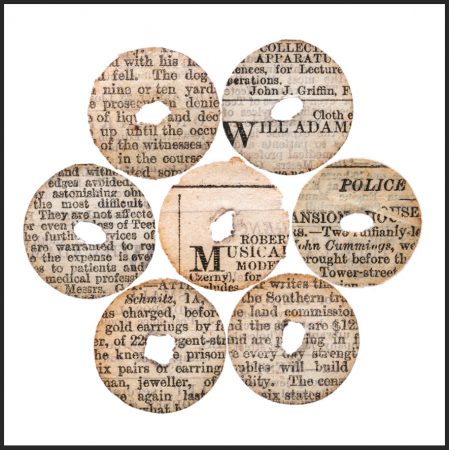
Idea 1
I was working on the grouping of the newspaper washers that were most interesting in terms of their story content. I was battling with the idea of arranging eight washers – thinking of an octave – but seven go together for more pleasingly within some kind of frame.
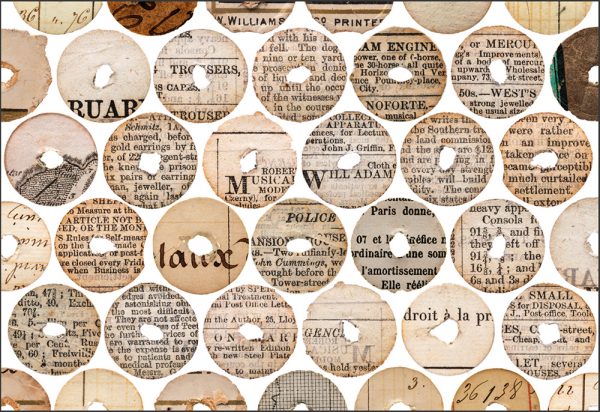
Idea 2
These are all of the visually interesting washers arranged so that the negative white space is kept to a minimum. I intended to crop the washers around the edge to imply that there are many more beyond the edge of the frame, as there are, if all of the plain ones are included. I’m trying to create the arrangement so that the different shades and tones of the individual washers aren’t too similar side by side and that the overall image is well-balanced.
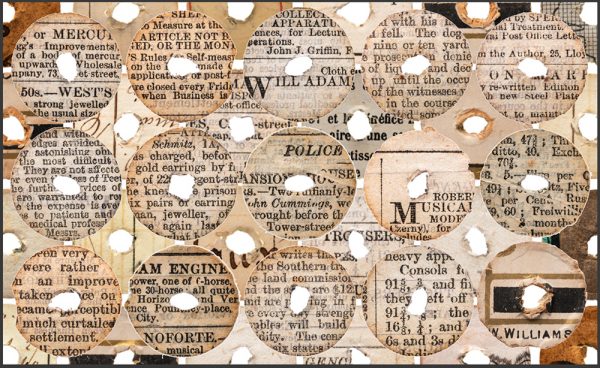
Idea 3
Layering of the washers so that the ones with the most interesting stories to tell are laid on top and the others, sometimes the reverse of the top ones, lie underneath slightly out of focus.
All of these ideas are mock-ups of the potential artwork rather than them being the finished item. This particular idea may look quite different if it is taken to artwork because at the moment it is clear to see the white edge of the washers on the top. This was very important when I originally photographed the washers Individually, in fine detail, because their fine edges had wonderful textual detail where the paper fibres were starting to displace, and I wanted to make the most of this information in the images – harsh crop of their edges would devoid them of life. if this idea is taken to artwork, I would need to re-photograph them all in a single image using glass sheets to separate the layers of washers and so giving a similar effect.
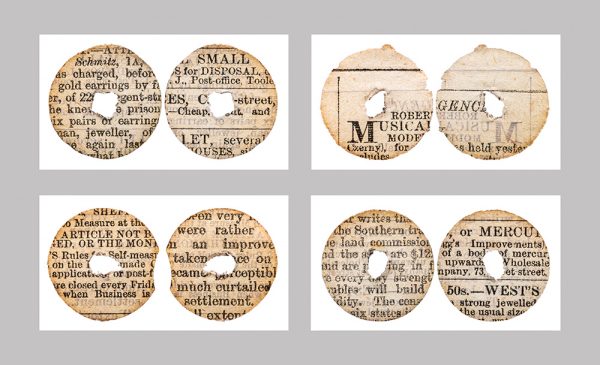
Idea 4
Pairing the front and backs of the most interesting washers. I’ve included four examples in this one image and my idea is that there would be several pairs of washers framed.
We might like to discuss mounting, framing, displaying etc over the phone as there are many options here.
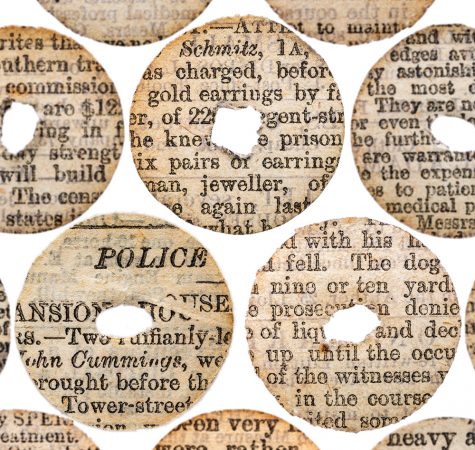
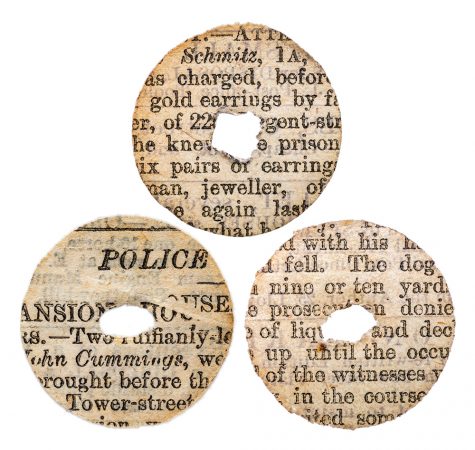
Ideas 5 & 6
Grouping of washers whose stories would be filed under the same category – in this case ‘crime stories’. Image 006 is the washers on their own grouped as an equilateral triangle but in 005 my intention was to make the image look as if one is noticing, and focusing on, the crime stories as all three washers are slightly raised and in sharp focus, whereas the other parts of washers in the image are slightly out of focus and not quite as bright.
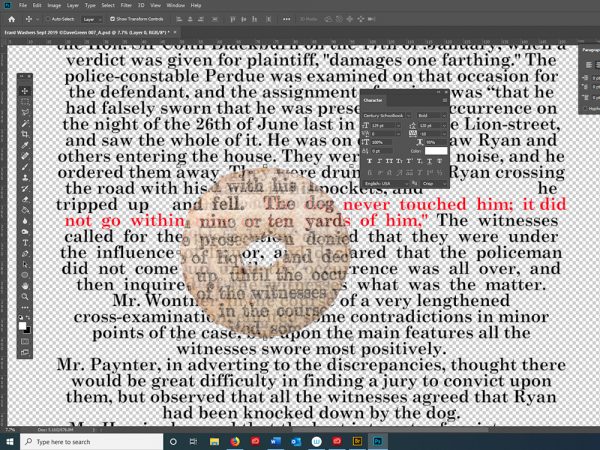
Idea 7
 I have been really hoping I could match up a washer with the actual text from the newspaper it came from and then crop a portion of the real paper as a background to the washer itself. I’ve included this idea as it was very much one that I wanted to pursue but I feel that it is just not going to happen! This example (see thumbnail image) is the absolute closest match that I found of a washer to the newspaper it was printed in. It would be hard to believe that this washer wasn’t cut from the Morning Chronicle of Thursday, the 7th of February 1861, the font is the same, if you look at my example image 007 (see previous blog for more) you can see that the text starts to line-up exactly and it finishes lining up almost exactly in the line ‘Mr Wontner in the course of’, which suggests that the column width was the same the font size in relationship to the line height is the same; but it still doesn’t match! I even attempted to add the text myself (see screenshot above) so that I could fine-tune all of those sizes but it doesn’t follow any of today’s standards and so I had to finish that idea somewhat defeated!
I have been really hoping I could match up a washer with the actual text from the newspaper it came from and then crop a portion of the real paper as a background to the washer itself. I’ve included this idea as it was very much one that I wanted to pursue but I feel that it is just not going to happen! This example (see thumbnail image) is the absolute closest match that I found of a washer to the newspaper it was printed in. It would be hard to believe that this washer wasn’t cut from the Morning Chronicle of Thursday, the 7th of February 1861, the font is the same, if you look at my example image 007 (see previous blog for more) you can see that the text starts to line-up exactly and it finishes lining up almost exactly in the line ‘Mr Wontner in the course of’, which suggests that the column width was the same the font size in relationship to the line height is the same; but it still doesn’t match! I even attempted to add the text myself (see screenshot above) so that I could fine-tune all of those sizes but it doesn’t follow any of today’s standards and so I had to finish that idea somewhat defeated!
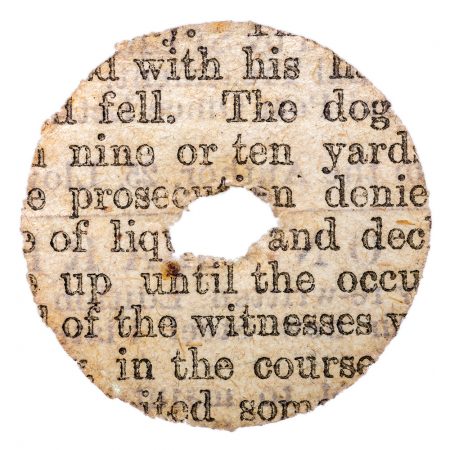 Idea 8
Idea 8
Simply a number of large images of single washers. It feels like going backwards to move forward but these are still strong images in their own right and the single washers now have far more weight with the complete stories that can be attached to them (not in a literal artwork sense!).
I think that whatever final artwork is decided upon it would also be worthwhile to have a small archival box file, which I am going to order, to safely store the washers. They will be held in sleeves that are designed for archival coin storage, as they are a similar size and value. I’m thinking that a set of images of the single washers could also be added to this file, approximately 10 in.². This would give you a handy reference and would be a lovely object on its own. A copy of all of the newspaper stories could also be added to the file.”
It seemed right at this point to open the dialogue up to include FaceTime video conversations, to progress the commission through live meetings. Some of those discussions follow my clients words in italics:
“Concerning the art work, I am thinking you should perhaps focus on several ideas. Although you said it wasn’t really working, I think you MUST incorporate the “background” newspaper into your design. To me, the newspaper IS the story and without it as a background, there is no context for the washer. The background newspaper should show the name of the publication along with the date of course. I don’t think it really matters if that requires some cropping or whatever. I visualize something similar to No. 7 in your ideas with perhaps a larger (landscape) newspaper in the background with the “washer” exhibited similar to what you have now. Again, I don’t think it matters that much that the washer is not an exact match. Just try to get close.”
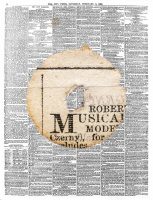 “I think a second track would be how to present one of more of the washers photographically and I really like much of what you sent. My view generally is “less is more,” so that maybe even one washer with the right background and enlarged to the right size would suffice. I really like the “Czerny” washer for obvious reasons (Carl Czerny as in Beethoven’s student.)”
“I think a second track would be how to present one of more of the washers photographically and I really like much of what you sent. My view generally is “less is more,” so that maybe even one washer with the right background and enlarged to the right size would suffice. I really like the “Czerny” washer for obvious reasons (Carl Czerny as in Beethoven’s student.)”
It was clear that my client was very keen on this particular washer because an earlier 1803 piano model had been Beethoven’s choice for 8 years. I had found the advertisement, relating to the text on the washer, in The City Press of 9th February 1861. It was for the ‘279th Edition of Hamilton’s Modern Instructions for Pianoforte enlarged and fingered by Czerny’. But it had little of the graphic quality present in the actual elusive newspaper source.
We talked around different print media, Giclee, aluminium, canvas, glass and of shape and size of finished artwork. I arranged the printing of a washer on the German fine-art Paper, Hahnemuhle Photo Rag, so that my client would get an idea of the print quality achievable.
“I’d like to see the “final version” of FOUR washers with newspaper backing. Do we have 4? How about the Czerny? I can see framing and hanging four of them in my studio, OR just one larger poster. Haven’t decided yet.
I personally don’t find the glass appealing but I’ve never seen a sample. BUT how about multiple washers (6?) “under” glass in approximately 8 inch squares? Might be very cool.
Appreciate your continuing thoughts.”
I WeTransfered draught versions of the ‘Czerny’ washer and three others whose stories had been paired up with newspaper articles that had been found. Although at this stage only the ‘Southern trade’ washer in the Morning Advertiser of the 7th of February 1861 is close to finished. I made it clear that these were just indications of what might be but that I thought it best to leave them as they are until I got back to the British library, in a couple of weeks’ time and saw the Telegraph newspapers from Feb 1861.
“The two police stories, ‘John Cummings’ and ‘the dog’ that I have paired up with the morning Chronicle of February 7, 1861 might work as they are, but the washers certainly don’t match like The washer does for southern trade. I have indicated where the washer would be within the articles (although it is not the actual washer that I am using) so that the viewer of the piece would be able to read the article and understand the relationship to the washer.
The washer about ‘the dog that never touched him, it did not go within nine or 10 yards of him’, is an almost match, in terms that the beginning of it and the end of it match up but there is a mismatch in the centre. So here I conclude that it may well be from this newspaper but might be from a different edition or the mismatch might be due to production shaking, rattling, of the presses. Therefore, we could decide to just have this washer with the morning chronicle of the 7th of February and put the ‘John Cummings’ washer with another article of the same story from a different newspaper, if the actual one doesn’t turn up in the Telegraph.”
Copyright was potentially going to be an issue, if the artwork was created through a combination of the washers and the newspaper, so I contacted ‘Images Online’ at the British Library explaining what I was doing and how I wanted to use the material. I got a very quick and thankfully positive response back:
“If you found and downloaded the image from British Newspaper Archive, you are free to use the copy, the fees have been waived. Please credit the Library as the original source.”
I was not entirely happy with all the close-up photographs of washers I had made in the studio. Don’t get me wrong they looked great, but enlarged to 100% I was noticing some issues with focus and clarity that I believed I could make better. I’m always happy to reshoot something, rather than feeling I could have done better, so another shoot was organised, this time using a close-up ring (instead of a macro-lens) and carefully focusing everything manually. I was really pleased with the results and sent one high quality picture via WeTransfer to my client so that he would be able to see it blown up to 100% on his computer screen and notice the wonderful fibres of the paper coming through in the image. This could be printed to 3 ft.² as a fine quality print.
My closing sentences from late October were as follows:
“I’m next in London on Tuesday, the 12th of November so I shall put everything on hold now until that date. Once I have looked at the Telegraph newspapers, I really will be able to conclude that all of the newspapers still existing will have been thoroughly searched.”